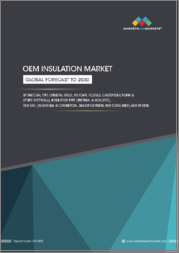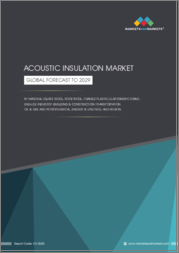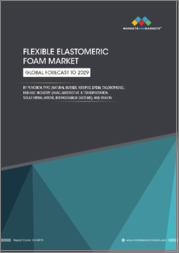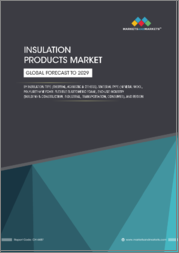
|
시장보고서
상품코드
1719228
이소프렌 고무 시장 : 세계 산업 규모, 점유율, 동향, 기회, 예측 - 판매 채널별, 최종 용도별, 지역별, 경쟁별(2020-2030년)Isoprene Rubber Market - Global Industry Size, Share, Trends, Opportunity, and Forecast, Segmented By Sales Channel, By End Use, By Region and Competition, 2020-2030F |
||||||
이소프렌 고무 세계 시장은 2024년에는 17억 6,921만 달러에 달할 것으로 예상되며, 2030년에는 22억 5,675만 달러에 달할 것으로 예상되며, 예측 기간 동안 3.40%의 CAGR로 확대될 것으로 예상됩니다.
| 시장 개요 | |
|---|---|
| 예측 기간 | 2026-2030년 |
| 시장 규모 : 2024년 | 17억 6,921만 달러 |
| 시장 규모 : 2030년 | 22억 5,675만 달러 |
| CAGR : 2025-2030년 | 3.40% |
| 급성장 부문 | 다이렉트 |
| 최대 시장 | 아시아태평양 |
아시아태평양과 라틴아메리카의 신흥 경제 국가를 중심으로 한 자동차 산업의 지속적인 확장으로 시장은 꾸준히 성장하고 있습니다. 자동차 생산량이 증가함에 따라 고성능 타이어, 방진 마운트, 씰링 부품에 대한 수요도 증가하고 있으며, 이소프렌 고무는 우수한 내구성과 탄성으로 인해 널리 사용되고 있습니다. 또한, 전기자동차(EV)로의 전환은 재료 사양을 재구성하여 첨단 합성 고무 컴파운드의 채택을 더욱 촉진하고 있습니다.
시장 전망은 밝지만, 원자재 가격 변동과 공급망 혼란과 같은 도전과제는 여전히 남아있습니다. 제조업체들은 이러한 리스크를 줄이고 사업의 연속성을 보장하기 위해 지역 생산기지에 대한 투자 및 전략적 공급계약 체결을 확대하고 있습니다.
주요 시장 촉진요인
자동차 산업의 성장
이소프렌 고무의 우수한 탄성, 탄력성, 내마모성은 고성능 타이어 및 중요한 자동차 부품 제조에 적합한 소재입니다.
자동차 업계에서는 연비 향상과 배기가스 배출량 감소를 위해 가볍고 내구성이 뛰어난 소재에 대한 관심이 높아지면서 시장 성장을 더욱 촉진하고 있습니다.
주요 시장 과제
원자재 가격 변동
세계 이소프렌 고무 시장은 특히 이소프렌 모노머 및 관련 석유화학 유도체 원료 가격의 변동으로 인해 큰 도전에 직면해 있습니다.
이소프렌의 생산은 나프타 기반 분해와 밀접한 관련이 있기 때문에 가격 설정은 원유 시세 변동에 매우 민감합니다.
지정학적 긴장, 에너지 위기, 공급망 병목현상은 갑작스러운 가격 급등을 유발하고 제조업체의 비용 예측 가능성을 손상시킬 수 있습니다.
이러한 변동성은 자동차, 헬스케어, 접착제 등 다운스트림 부문의 장기적인 조달 및 자금 계획을 복잡하게 만듭니다.
주요 시장 동향
헬스케어 산업 확대
헬스케어 산업의 급속한 확장은 세계 이소프렌 고무 시장의 주요 성장 요인으로 부상하고 있습니다.
대부분의 신흥 경제국에서 의료비 지출은 GDP의 10% 이상을 차지하고 있으며, 미국에서는 2021년 의료비 지출이 2.7% 증가하여 총 4조 3,000억 달러, GDP의 18.3%에 달할 것으로 예상됩니다.
목차
제1장 개요
제2장 조사 방법
제3장 주요 요약
제4장 COVID-19가 세계의 이소프렌 고무 시장에 미치는 영향
제5장 세계의 이소프렌 고무 시장 전망
- 시장 규모 및 예측
- 금액별
- 시장 점유율과 예측
- 판매 채널별(직접, 간접)
- 용도별(자동차, 라텍스 제품, 산업 용도, 접착제 및 실란트, 소비재, 기타)
- 지역별
- 기업별(2024)
- 시장 맵
제6장 북미의 이소프렌 고무 시장 전망
- 시장 규모 및 예측
- 시장 점유율과 예측
- 북미 : 국가별 분석
- 미국
- 멕시코
- 캐나다
제7장 유럽의 이소프렌 고무 시장 전망
- 시장 규모 및 예측
- 시장 점유율과 예측
- 유럽 : 국가별 분석
- 프랑스
- 독일
- 영국
- 이탈리아
- 스페인
제8장 아시아태평양의 이소프렌 고무 시장 전망
- 시장 규모 및 예측
- 시장 점유율과 예측
- 아시아태평양 : 국가별 분석
- 중국
- 인도
- 한국
- 일본
- 호주
제9장 남미의 이소프렌 고무 시장 전망
- 시장 규모 및 예측
- 시장 점유율과 예측
- 남미 : 국가별 분석
- 브라질
- 아르헨티나
- 콜롬비아
제10장 중동 및 아프리카의 이소프렌 고무 시장 전망
- 시장 규모 및 예측
- 시장 점유율과 예측
- 중동 및 아프리카 : 국가별 분석
- 남아프리카공화국
- 사우디아라비아
- 아랍에미리트
제11장 시장 역학
- 성장 촉진요인
- 과제
제12장 시장 동향과 발전
- 인수합병
- 제품 출시
- 최근 동향
제13장 세계의 이소프렌 고무 시장 : SWOT 분석
제14장 Porter's Five Forces 분석
- 업계내 경쟁
- 신규 참여의 가능성
- 공급업체의 능력
- 고객의 능력
- 대체품의 위협
제15장 경쟁 구도
- Qingdao Yikesi New Material Co., Ltd.
- LLC Tolyattikauchuk
- PJSC Nizhnekamskneftekhim
- Goodyear Tire and Rubber Company
- Kraton JSR Elastomers K.K
- Ningbo Jinhai Chenguang Chemical Corporation
- Xinjiang Tianli Petrochemical Co., Ltd
- Guangdong Luzhonghua New Materials Co., Ltd.
- Zibo Luhua Hongjin New Material Group Co.,Ltd
- Liaoning Panjin Zhenao Chemical
제16장 전략적 제안
제17장 조사 회사 소개 및 면책사항
ksm 25.05.23The Global Isoprene Rubber Market was valued at USD 1,769.21 million in 2024 and is projected to reach USD 2,256.75 million by 2030, expanding at a CAGR of 3.40% during the forecast period.
| Market Overview | |
|---|---|
| Forecast Period | 2026-2030 |
| Market Size 2024 | USD 1,769.21 Million |
| Market Size 2030 | USD 2,256.75 Million |
| CAGR 2025-2030 | 3.40% |
| Fastest Growing Segment | Direct |
| Largest Market | Asia Pacific |
The market is witnessing steady growth, primarily driven by the sustained expansion of the automotive industry, particularly across developing economies in Asia-Pacific and Latin America. As automotive production increases, so too does the demand for high-performance tires, anti-vibration mounts, and sealing components, where isoprene rubber is widely utilized for its superior durability and resilience. Additionally, the transition toward electric vehicles (EVs) is reshaping material specifications, further boosting the adoption of advanced synthetic rubber compounds.
Despite the market's positive outlook, challenges such as raw material price volatility and supply chain disruptions persist. Manufacturers are increasingly investing in regional production hubs and forming strategic supply agreements to mitigate these risks and ensure business continuity.
Key Market Drivers
Growth in Automotive Industry
Isoprene rubber's superior elasticity, resilience, and abrasion resistance make it a preferred material for manufacturing high-performance tires and critical automotive components.
With 95% of consumers in Saudi Arabia owning a car-the highest rate among surveyed nations-the rise in vehicle ownership in emerging markets, coupled with EV adoption in developed economies, is driving tire production and consequently, demand for isoprene rubber.
The automotive sector's emphasis on lightweight and durable materials to enhance fuel efficiency and reduce emissions is further supporting market growth.
For instance, Goodyear, in collaboration with DuPont Biosciences, introduced BioIsoprene, a bio-based monomer for high-performance rubber production. Additionally, Goodyear's BioTRED tires, utilizing nanodroplets of complex starch as a filler material, have demonstrated up to a 5% improvement in fuel efficiency through reduced rolling resistance.
Beyond tires, isoprene rubber is increasingly used in engine mounts, suspension bushings, and anti-vibration systems, particularly in high-performance and heavy-duty vehicles, further fueling market expansion.
Key Market Challenges
Volatility in Raw Material Prices
The global isoprene rubber market faces significant challenges due to the volatility in raw material prices, particularly for isoprene monomer and related petrochemical derivatives.
Since isoprene production is closely tied to naphtha-based cracking, its pricing is highly sensitive to fluctuations in crude oil markets.
Geopolitical tensions, energy crises, and supply chain bottlenecks can trigger abrupt price spikes, undermining cost predictability for manufacturers.
This volatility complicates long-term procurement and financial planning for downstream sectors like automotive, healthcare, and adhesives.
In response, industry players are exploring alternative feedstocks, enhancing operational efficiency, and pursuing strategic partnerships to hedge against raw material risks and maintain profitability.
Key Market Trends
Expansion in Healthcare Industry
The healthcare industry's rapid expansion is emerging as a major growth driver for the global isoprene rubber market.
Healthcare spending accounts for over 10% of GDP in most developed economies; in the United States, healthcare expenditures rose by 2.7% in 2021, totaling USD 4.3 trillion, or 18.3% of GDP.
Traditionally dominated by automotive and industrial applications, the isoprene rubber market is now gaining traction in medical and healthcare sectors, where the material's biocompatibility, hypoallergenic properties, and superior elasticity are highly valued.
Isoprene rubber is increasingly being utilized in products such as medical gloves, catheters, and various healthcare equipment, further diversifying the market's end-use portfolio and driving future growth opportunities.
Key Market Players
- Qingdao Yikesi New Material Co., Ltd.
- LLC Tolyattikauchuk
- PJSC Nizhnekamskneftekhim
- Goodyear Tire and Rubber Company
- Kraton JSR Elastomers K.K
- Ningbo Jinhai Chenguang Chemical Corporation
- Xinjiang Tianli Petrochemical Co., Ltd.
- Guangdong Luzhonghua New Materials Co., Ltd.
- Zibo Luhua Hongjin New Material Group Co., Ltd.
- Liaoning Panjin Zhenao Chemical
Report Scope:
In this report, the Global Isoprene Rubber Market has been segmented into the following categories, along with detailed industry trends:
Isoprene Rubber Market, By Sales Channel:
- Direct
- Indirect
Isoprene Rubber Market, By End Use:
- Automotive
- Latex Products
- Industrial Application
- Adhesives & Sealants
- Consumer Goods
- Others
Isoprene Rubber Market, By Region:
- North America
- United States
- Canada
- Mexico
- Europe
- France
- United Kingdom
- Italy
- Germany
- Spain
- Asia-Pacific
- China
- India
- Japan
- Australia
- South Korea
- South America
- Brazil
- Argentina
- Colombia
- Middle East & Africa
- South Africa
- Saudi Arabia
- UAE
Competitive Landscape
Company Profiles: Comprehensive analysis of major companies operating in the Global Isoprene Rubber Market.
Available Customizations:
TechSci Research offers customized versions of the Global Isoprene Rubber Market report based on specific client requirements, including:
- Detailed analysis and profiling of additional market players (up to five).
Table of Contents
1. Product Overview
- 1.1. Market Definition
- 1.2. Scope of the Market
- 1.2.1. Markets Covered
- 1.2.2. Years Considered for Study
- 1.2.3. Key Market Segmentations
2. Research Methodology
- 2.1. Objective of the Study
- 2.2. Baseline Methodology
- 2.3. Key Industry Partners
- 2.4. Major Association and Secondary Sources
- 2.5. Forecasting Methodology
- 2.6. Data Triangulation & Validation
- 2.7. Assumptions and Limitations
3. Executive Summary
- 3.1. Overview of the Market
- 3.2. Overview of Key Market Segmentations
- 3.3. Overview of Key Market Players
- 3.4. Overview of Key Regions/Countries
- 3.5. Overview of Market Drivers, Challenges, and Trends
4. Impact of COVID-19 on Global Isoprene Rubber Market
5. Global Isoprene Rubber Market Outlook
- 5.1. Market Size & Forecast
- 5.1.1. By Value
- 5.2. Market Share & Forecast
- 5.2.1. By Sales Channel (Direct, Indirect)
- 5.2.2. By End Use (Automotive, Latex Products, Industrial Application, Adhesives & Sealants, Consumer Goods, Others)
- 5.2.3. By Region
- 5.2.4. By Company (2024)
- 5.3. Market Map
6. North America Isoprene Rubber Market Outlook
- 6.1. Market Size & Forecast
- 6.1.1. By Value
- 6.2. Market Share & Forecast
- 6.2.1. By Sales Channel
- 6.2.2. By End Use
- 6.2.3. By Country
- 6.3. North America: Country Analysis
- 6.3.1. United States Isoprene Rubber Market Outlook
- 6.3.1.1. Market Size & Forecast
- 6.3.1.1.1. By Value
- 6.3.1.2. Market Share & Forecast
- 6.3.1.2.1. By Sales Channel
- 6.3.1.2.2. By End Use
- 6.3.1.1. Market Size & Forecast
- 6.3.2. Mexico Isoprene Rubber Market Outlook
- 6.3.2.1. Market Size & Forecast
- 6.3.2.1.1. By Value
- 6.3.2.2. Market Share & Forecast
- 6.3.2.2.1. By Sales Channel
- 6.3.2.2.2. By End Use
- 6.3.2.1. Market Size & Forecast
- 6.3.3. Canada Isoprene Rubber Market Outlook
- 6.3.3.1. Market Size & Forecast
- 6.3.3.1.1. By Value
- 6.3.3.2. Market Share & Forecast
- 6.3.3.2.1. By Sales Channel
- 6.3.3.2.2. By End Use
- 6.3.3.1. Market Size & Forecast
- 6.3.1. United States Isoprene Rubber Market Outlook
7. Europe Isoprene Rubber Market Outlook
- 7.1. Market Size & Forecast
- 7.1.1. By Value
- 7.2. Market Share & Forecast
- 7.2.1. By Sales Channel
- 7.2.2. By End Use
- 7.2.3. By Country
- 7.3. Europe: Country Analysis
- 7.3.1. France Isoprene Rubber Market Outlook
- 7.3.1.1. Market Size & Forecast
- 7.3.1.1.1. By Value
- 7.3.1.2. Market Share & Forecast
- 7.3.1.2.1. By Sales Channel
- 7.3.1.2.2. By End Use
- 7.3.1.1. Market Size & Forecast
- 7.3.2. Germany Isoprene Rubber Market Outlook
- 7.3.2.1. Market Size & Forecast
- 7.3.2.1.1. By Value
- 7.3.2.2. Market Share & Forecast
- 7.3.2.2.1. By Sales Channel
- 7.3.2.2.2. By End Use
- 7.3.2.1. Market Size & Forecast
- 7.3.3. United Kingdom Isoprene Rubber Market Outlook
- 7.3.3.1. Market Size & Forecast
- 7.3.3.1.1. By Value
- 7.3.3.2. Market Share & Forecast
- 7.3.3.2.1. By Sales Channel
- 7.3.3.2.2. By End Use
- 7.3.3.1. Market Size & Forecast
- 7.3.4. Italy Isoprene Rubber Market Outlook
- 7.3.4.1. Market Size & Forecast
- 7.3.4.1.1. By Value
- 7.3.4.2. Market Share & Forecast
- 7.3.4.2.1. By Sales Channel
- 7.3.4.2.2. By End Use
- 7.3.4.1. Market Size & Forecast
- 7.3.5. Spain Isoprene Rubber Market Outlook
- 7.3.5.1. Market Size & Forecast
- 7.3.5.1.1. By Value
- 7.3.5.2. Market Share & Forecast
- 7.3.5.2.1. By Sales Channel
- 7.3.5.2.2. By End Use
- 7.3.5.1. Market Size & Forecast
- 7.3.1. France Isoprene Rubber Market Outlook
8. Asia Pacific Isoprene Rubber Market Outlook
- 8.1. Market Size & Forecast
- 8.1.1. By Value
- 8.2. Market Share & Forecast
- 8.2.1. By Sales Channel
- 8.2.2. By End Use
- 8.2.3. By Country
- 8.3. Asia Pacific: Country Analysis
- 8.3.1. China Isoprene Rubber Market Outlook
- 8.3.1.1. Market Size & Forecast
- 8.3.1.1.1. By Value
- 8.3.1.2. Market Share & Forecast
- 8.3.1.2.1. By Sales Channel
- 8.3.1.2.2. By End Use
- 8.3.1.1. Market Size & Forecast
- 8.3.2. India Isoprene Rubber Market Outlook
- 8.3.2.1. Market Size & Forecast
- 8.3.2.1.1. By Value
- 8.3.2.2. Market Share & Forecast
- 8.3.2.2.1. By Sales Channel
- 8.3.2.2.2. By End Use
- 8.3.2.1. Market Size & Forecast
- 8.3.3. South Korea Isoprene Rubber Market Outlook
- 8.3.3.1. Market Size & Forecast
- 8.3.3.1.1. By Value
- 8.3.3.2. Market Share & Forecast
- 8.3.3.2.1. By Sales Channel
- 8.3.3.2.2. By End Use
- 8.3.3.1. Market Size & Forecast
- 8.3.4. Japan Isoprene Rubber Market Outlook
- 8.3.4.1. Market Size & Forecast
- 8.3.4.1.1. By Value
- 8.3.4.2. Market Share & Forecast
- 8.3.4.2.1. By Sales Channel
- 8.3.4.2.2. By End Use
- 8.3.4.1. Market Size & Forecast
- 8.3.5. Australia Isoprene Rubber Market Outlook
- 8.3.5.1. Market Size & Forecast
- 8.3.5.1.1. By Value
- 8.3.5.2. Market Share & Forecast
- 8.3.5.2.1. By Sales Channel
- 8.3.5.2.2. By End Use
- 8.3.5.1. Market Size & Forecast
- 8.3.1. China Isoprene Rubber Market Outlook
9. South America Isoprene Rubber Market Outlook
- 9.1. Market Size & Forecast
- 9.1.1. By Value
- 9.2. Market Share & Forecast
- 9.2.1. By Sales Channel
- 9.2.2. By End Use
- 9.2.3. By Country
- 9.3. South America: Country Analysis
- 9.3.1. Brazil Isoprene Rubber Market Outlook
- 9.3.1.1. Market Size & Forecast
- 9.3.1.1.1. By Value
- 9.3.1.2. Market Share & Forecast
- 9.3.1.2.1. By Sales Channel
- 9.3.1.2.2. By End Use
- 9.3.1.1. Market Size & Forecast
- 9.3.2. Argentina Isoprene Rubber Market Outlook
- 9.3.2.1. Market Size & Forecast
- 9.3.2.1.1. By Value
- 9.3.2.2. Market Share & Forecast
- 9.3.2.2.1. By Sales Channel
- 9.3.2.2.2. By End Use
- 9.3.2.1. Market Size & Forecast
- 9.3.3. Colombia Isoprene Rubber Market Outlook
- 9.3.3.1. Market Size & Forecast
- 9.3.3.1.1. By Value
- 9.3.3.2. Market Share & Forecast
- 9.3.3.2.1. By Sales Channel
- 9.3.3.2.2. By End Use
- 9.3.3.1. Market Size & Forecast
- 9.3.1. Brazil Isoprene Rubber Market Outlook
10. Middle East and Africa Isoprene Rubber Market Outlook
- 10.1. Market Size & Forecast
- 10.1.1. By Value
- 10.2. Market Share & Forecast
- 10.2.1. By Sales Channel
- 10.2.2. By End Use
- 10.2.3. By Country
- 10.3. MEA: Country Analysis
- 10.3.1. South Africa Isoprene Rubber Market Outlook
- 10.3.1.1. Market Size & Forecast
- 10.3.1.1.1. By Value
- 10.3.1.2. Market Share & Forecast
- 10.3.1.2.1. By Sales Channel
- 10.3.1.2.2. By End Use
- 10.3.1.1. Market Size & Forecast
- 10.3.2. Saudi Arabia Isoprene Rubber Market Outlook
- 10.3.2.1. Market Size & Forecast
- 10.3.2.1.1. By Value
- 10.3.2.2. Market Share & Forecast
- 10.3.2.2.1. By Sales Channel
- 10.3.2.2.2. By End Use
- 10.3.2.1. Market Size & Forecast
- 10.3.3. UAE Isoprene Rubber Market Outlook
- 10.3.3.1. Market Size & Forecast
- 10.3.3.1.1. By Value
- 10.3.3.2. Market Share & Forecast
- 10.3.3.2.1. By Sales Channel
- 10.3.3.2.2. By End Use
- 10.3.3.1. Market Size & Forecast
- 10.3.1. South Africa Isoprene Rubber Market Outlook
11. Market Dynamics
- 11.1. Drivers
- 11.2. Challenges
12. Market Trends & Developments
- 12.1. Merger & Acquisition (If Any)
- 12.2. Product Launches (If Any)
- 12.3. Recent Developments
13. Global Isoprene Rubber Market: SWOT Analysis
14. Porters Five Forces Analysis
- 14.1. Competition in the Industry
- 14.2. Potential of New Entrants
- 14.3. Power of Suppliers
- 14.4. Power of Customers
- 14.5. Threat of Substitute Products
15. Competitive Landscape
- 15.1. Qingdao Yikesi New Material Co., Ltd.
- 15.1.1. Business Overview
- 15.1.2. Company Snapshot
- 15.1.3. Products & Services
- 15.1.4. Financials (As Reported)
- 15.1.5. Recent Developments
- 15.1.6. Key Personnel Details
- 15.1.7. SWOT Analysis
- 15.2. LLC Tolyattikauchuk
- 15.3. PJSC Nizhnekamskneftekhim
- 15.4. Goodyear Tire and Rubber Company
- 15.5. Kraton JSR Elastomers K.K
- 15.6. Ningbo Jinhai Chenguang Chemical Corporation
- 15.7. Xinjiang Tianli Petrochemical Co., Ltd
- 15.8. Guangdong Luzhonghua New Materials Co., Ltd.
- 15.9. Zibo Luhua Hongjin New Material Group Co.,Ltd
- 15.10. Liaoning Panjin Zhenao Chemical
16. Strategic Recommendations
17. About Us & Disclaimer
(주말 및 공휴일 제외)


















